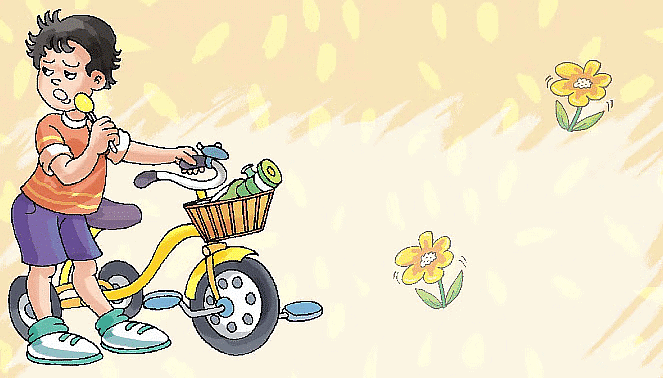Nobody`s Friend Class 5 Worksheet English Marigold Poem 8

Q1: Tick (✔) the Correct Answer
(i) She had some sweets that she wouldn’t ………………
(a) share (✔)
(b) fare ( )
(c) care ( )
(d) none of these ( )
(ii) He had some ……………….. , and ate every bit.
(a) coffee ( )
(b) toffee (✔)
(c) loafy ( )
(d) all of these ( )
(iii) Here is half my ……………. and half my cake.
(a) apple (✔)
(b) orange ( )
(c) mango ( )
(d) banana ( )
Q2: True or False
(i) The girl in the first stanza of the poem did not like to share her sweets.
Ans: True
The poem states, “She had some sweets that she wouldn’t share,” which clearly shows that the girl did not like to share her sweets.
(ii) One child wanted to share stuff with others in the poem.
Ans: True
The last stanza of the poem describes a child who says, “I’ll share all of my sweets with you,” showing that this child is willing to share.
(iii) The boy in the poem liked to share his tricycle.
Ans: False
The poem states, “He had a tricycle he wouldn’t lend,” which meAns he did not like to share his tricycle.
(iv)The boy in the poem is everybody’s friend.
Ans: False
The poem says, “He’s nobody’s friend!” meaning that the boy does not share and is not friendly with others.
Q3: Pick the odd ones out and give reason
(i) lend, give, donate, take
Ans: take
The words "lend," "give," and "donate" all involve offering something to others, while "take" means to receive, which is the opposite.
(ii) share, bell, care, dare
Ans: bell
"Share," "care," and "dare" all rhyme, whereas "bell" does not fit the pattern.
(iii) friend, buddy, chum, enemy
Ans: enemy
"Friend," "buddy," and "chum" all mean the same (companion), while "enemy" is the opposite.
(iv) lend, wind, bend, send
Ans: wind
"Lend," "bend," and "send" have a similar ending sound, but "wind" has a different pronunciation and meaning.
Q4: Discuss Questions
(i) Do you like to share your favourite food or toys with others? why?
Ans: I do like to share my favorite food and toys with others because it feels nice to make them happy and build stronger relationships. Sharing creates a sense of bonding and shows that I care about my friends' happiness too.
(ii) Who is your best friend? Can you describe him/her?
Ans: My best friend is Alex. He's incredibly kind, funny, and always there to support me. We enjoy similar hobbies and have shared countless adventures together, making our friendship very special.
(iii) Suppose you and your friends were very thirsty and there was only one glass of water. What would you do?
Ans: If there was only one glass of water and my friends and I were very thirsty, we could take turns drinking from the glass. We could also look for additional sources of water or try to find a fair way to distribute the water among us.
(iv) If you had a bat, could you play cricket by yourself?
Ans: No, I couldn't play cricket by myself with just a bat. Cricket is a team sport that requires players to bat and bowl alternatively. Without other players, I would need someone to bowl to me and field the ball.
Q5: Short Answer Questions
(i) Describe the girl mentioned in the poem. Why is she called "nobody's friend"?
Ans: The girl in the poem is described as someone who has sweets but doesn't want to share them, has books but won't lend them to anyone, and even has a doll but won't let anyone play with it. She is called "nobody's friend" because she doesn't share or be friendly with others.
(ii) What possessions does the boy in the poem have, and why is he also called "nobody's friend"?
Ans: The boy in the poem has toffee, a tricycle, and a toy train. He is called "nobody's friend" because he doesn't share his toffee, won't lend his tricycle to anyone, and won't let anyone play with his toy train.
(iii) How does the poet describe themselves in the poem's conclusion?
Ans: In the conclusion of the poem, the poet describes themselves as someone who is willing to share sweets, lend their ball and books, and even share their apple and cake. They are described as "everybody's friend" because they are friendly and sharing.
(iv) What is the central theme of the poem "Nobody's Friend" by Enid Blyton?
Ans: The central theme of the poem is the importance of sharing and being a good friend. It contrasts characters who don't share and are called "nobody's friend" with someone who is friendly and shares, being described as "everybody's friend."
(v) Why do you think sharing is important, according to the poem?
Ans: Sharing is important because it helps in building and maintaining friendships. In the poem, those who do not share are left with no friends, while the one who shares is everybody's friend. Sharing fosters positive relationships and makes people happier.
(vi) How does the poet convey the message that sharing is caring in the poem?
Ans: The poet conveys the message that sharing is caring by showing the contrast between characters who do not share their possessions and those who do. Those who share are depicted as friendly and everybody's friend, while those who don't share are called "nobody's friend."
(vii) Can you give an example from your own life when sharing made you a good friend?
Ans: Yes, for example, when I shared my toys with my friend during playtime, it made us good friends. We enjoyed playing together, and it strengthened our friendship.
(viii) How would you describe the attitude of the girl and the boy in the poem towards their possessions?
Ans: The girl and the boy in the poem have a possessive attitude towards their belongings. They are not willing to share or lend their sweets, books, toys, or treats with others.
(ix) What lesson can we learn from the poem "Nobody's Friend"?
Ans: The lesson we can learn from the poem is that sharing is an important quality in making and maintaining friends. Being generous and willing to share with others can help us become everyone's friend.
(x) How does the poet use repetition in the poem to emphasize the message?
Ans: The poet uses repetition by repeating the phrase "He's nobody's friend!" and "I'm your friend!" in the poem. This repetition emphasizes the contrast between those who don't share and those who do, reinforcing the message that sharing makes one a good friend.
|
22 videos|156 docs|67 tests
|
FAQs on Nobody`s Friend Class 5 Worksheet English Marigold Poem 8
| 1. What is the main theme of the article "Nobody's Friend"? |  |
| 2. How does the article depict the concept of friendship? |  |
| 3. Are there any key characters in "Nobody's Friend" that exemplify the theme? |  |
| 4. What lessons can readers learn from "Nobody's Friend"? |  |
| 5. How does the article relate to contemporary issues in social interactions? |  |
















